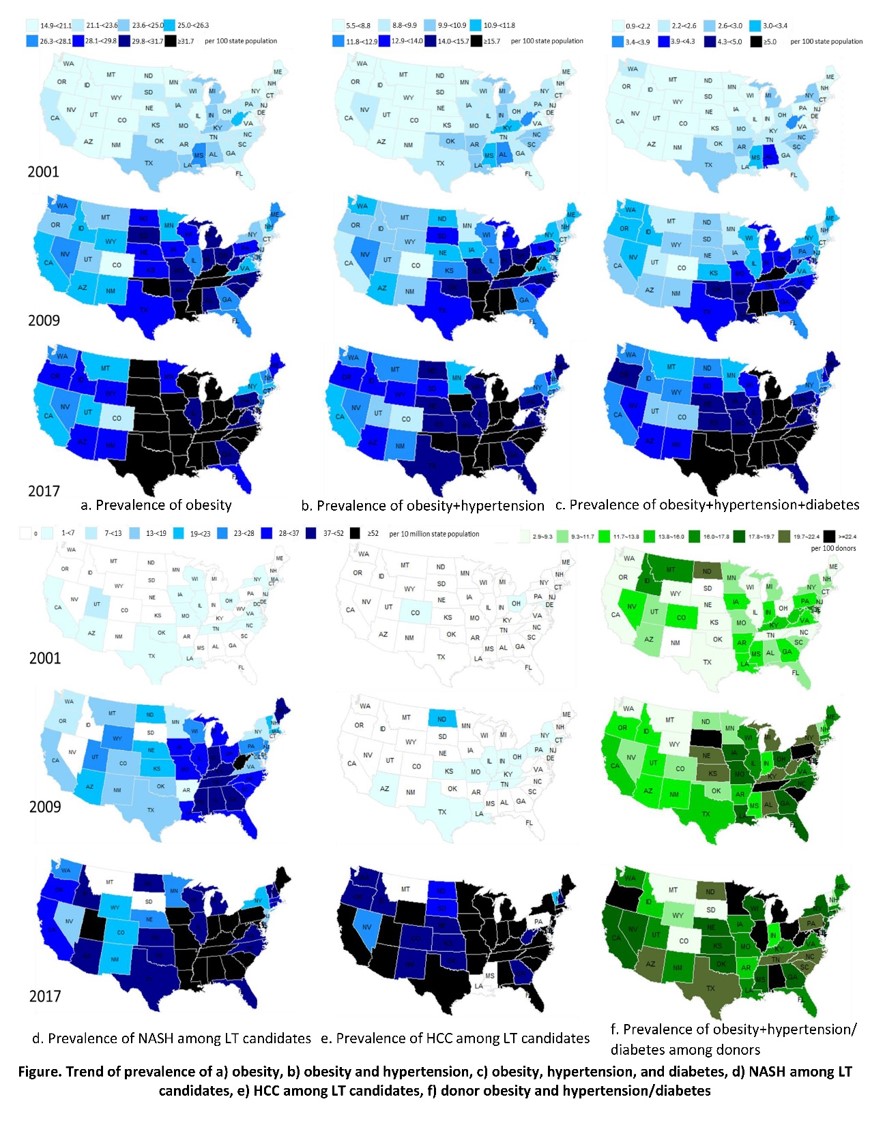State-level Trend in the Prevalence of Non-alcoholic Steatohepatitis for Liver Transplant Candidates in the United States, 2001-2017
S. Chang1, M. Wang1, M. Pozo2, D. Ladner2, D. Borja-Cacho2
1Washington University School of Medicine, Saint Louis, MO, 2Northwestern University, Chicago, IL
Meeting: 2021 American Transplant Congress
Abstract number: 184
Keywords: Hepatocellular carcinoma, Liver transplantation, Metabolic disease, Obesity
Topic: Clinical Science » Liver » Liver: MELD, Allocation and Donor Issues (DCD/ECD)
Session Information
Session Name: MELD, Allocation and Donor Issues
Session Type: Rapid Fire Oral Abstract
Date: Sunday, June 6, 2021
Session Time: 6:00pm-7:00pm
 Presentation Time: 6:15pm-6:20pm
Presentation Time: 6:15pm-6:20pm
Location: Virtual
*Purpose: As variation in the prevalence of obesity across states continues to grow, the prevalence of nonalcoholic steatohepatitis (NASH) is also rising. However, little is known about NASH cirrhosis as the primary indication for liver transplant (LT) at the state level.
*Methods: OPTN and BRFSS data from 2001-2017 were used. NASH as the primary indication for LT was defined as NASH as the primary diagnosis; and cryptogenic as the primary diagnosis and patient body mass index ≥35 or a diagnosis of diabetes. Patients’ state of residency at registration was geocoded. State-level prevalence was computed for obesity, obesity+hypertension, obesity+hypertension+diabetes (per 100 state population for all above), NASH and HCC for waitlisted patients (per 10 million state population), and obesity+hypertension or obesity+diabetes (obesity+hypertension/diabetes) for donors (per 100 state donors) were assessed. Linear time trend analyses were conducted on the prevalence for each state and the entire nation. One-sided tests to detect positive linear trends were used using α=0.05.
*Results: The prevalence of obesity, obesity+hypertension, obesity+hypertension+diabetes increased over time (see Figure). The prevalence of NASH and HCC increased in LT candidates. The prevalence of obesity+hypertension/diabetes in deceased liver donors had a significantly increasing trend (all p<0.0001). States with increasing trend in all studied prevalence included MD, NJ, PA, VA, WV, FL, GA, NC, SC, IL, MI, OH, WI, AL, TN, NE, MO, AR, LA, OK, TX, AZ, NV, UT, and WY. Except for donor prevalence in obesity+hypertension/diabetes, most of the states had increasing trend in the studied prevalence. NASH demonstrated an increased trend as the primary diagnosis for LT in all states, except for RI, VT, DC, NY (p=0.0635), SD, MT, NM, and OR (p=0.0516).
*Conclusions: The prevalence of NASH as the primary diagnosis for LT has increased significantly from 2001-2017 in almost all states (from 7 to 90 per 10 million state population). The prevalence of predisposing comorbidities has also increased in the general population including deceased donors. We found that these trends were correlated/aligned.
To cite this abstract in AMA style:
Chang S, Wang M, Pozo M, Ladner D, Borja-Cacho D. State-level Trend in the Prevalence of Non-alcoholic Steatohepatitis for Liver Transplant Candidates in the United States, 2001-2017 [abstract]. Am J Transplant. 2021; 21 (suppl 3). https://atcmeetingabstracts.com/abstract/state-level-trend-in-the-prevalence-of-non-alcoholic-steatohepatitis-for-liver-transplant-candidates-in-the-united-states-2001-2017/. Accessed December 18, 2025.« Back to 2021 American Transplant Congress

